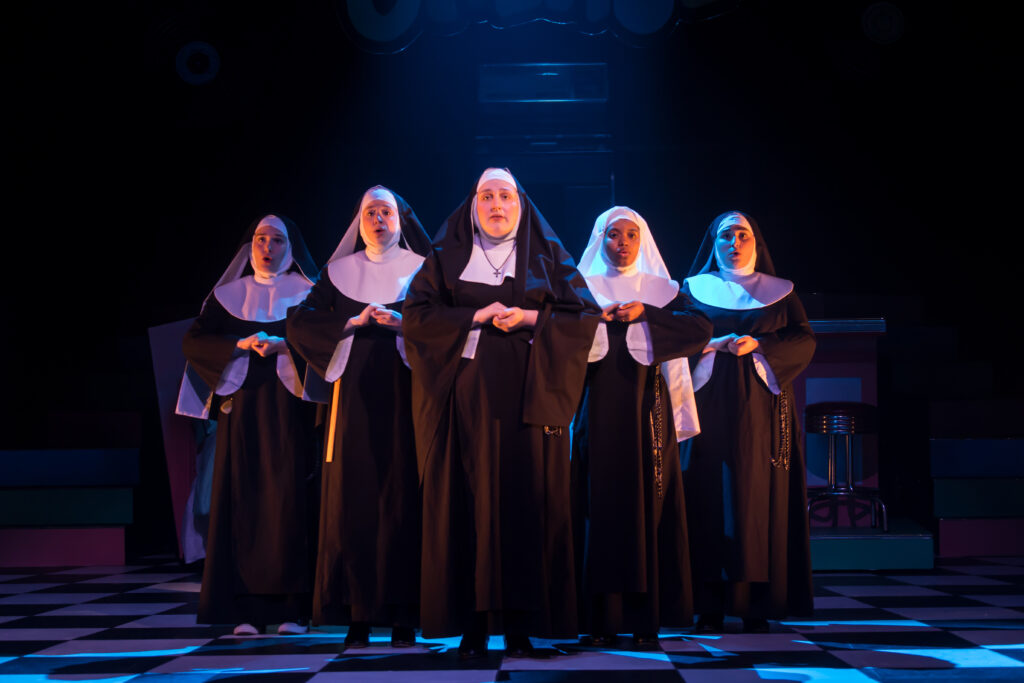A look through the eye of the needle of Nunsense
4 min read
From left to right, Emmy Beach, Nikki Rizzo, Amelia Emory, Ciarra Hopson and Cora Denny. | Photo by Geoff Greene
by SOPHIA TOMPKINS
Staff Editor
52 nuns are dead, 48 are buried and four are in the freezer. Why? Sister Julia, Child of God, made some bad soup and Mother Superior Mary Regina bought a TV before they could all be buried. Now the nuns are putting on a benefit to raise the money to bury the last four nuns before the health inspector comes by the convent and finds the dead sisters.
Preparations for UMW Theatre’s “Nunsense” began in early October after “Twelve Angry Jurors” came to a close. Most costumes in UMW Theatre productions are made in the campus costume shop. Stitchers work with shop assistants and the shop manager to create the costumes before tech week begins. Once tech week begins the shop keeps up with maintenance throughout its entirety. Dressers come in during tech week and oversee all costumes during tech and the run of the show.
“Costumes give more life to these characters, they all wear similar base costumes but have little details that tell a story of their own,” said freshman Alice Schnell.
While the process may seem simple, it takes a lot of effort and hands to make everything work. As a dresser and a stitcher, I do many things for this show. I help create the costumes before tech starts and keep track of the costumes while the show is running, as well as help with any quick changes during the show.
All five main actors wear a leotard, tights, a habit, a scapular, a belt, a rosary, a whimple, a guimpe and a veil. Sister Robert Anne also wears a fruit turban, tap shoes, a grim reaper robe and veil, a boa and a flower headband. Sister Mary Hubert also wears tap shoes and an apron. Mother Superior Mary Regina also wears an apron and a chef’s hat. Sister Mary Leo wears a bathrobe, pointe shoes, big bird slippers, a winged cornette and a flower headband. Sister Mary Amnesia wears an apron and a flower headband.
The two boys in the cast wear a cassock. Lukas the stage manager also wears a pair of pants, a surplice, a fanny pack and a headset. Brother Henry also wears a hood, a pair of shorts and a belt.
Every costume is made from a pattern. Stitchers take that part and transfer it to brown poster board paper. This is done so the patterns will last longer and so we have a record of the pattern. The pattern is then transferred to muslin, a beige-colored fabric, for mock-ups. After the mock-up is created, actors come in for a fitting, where they try on the mock-up and the designer can make any necessary changes. Once the mock-up is approved, the process begins to make the costume in fashion fabric.
Fashion fabric is any fabric that can be seen. For “Nunsense” most of the costumes were black. We had just enough black fabric for the show and we had to be very careful. We couldn’t waste any because we couldn’t get fabric that looked the same. If the costumes did not look the same on stage it would be very obvious under stage lights.
“I enjoyed the costumes. I feel they added to the show, especially the accessories added for specific musical numbers and scenes. I enjoyed the large hat during the dying nun scene. It added to the comedic effect of the scene,” said Kate Rutherford, a sophomore classics and history double major.
For the first round of fittings, a costume is completed in fashion fabric up to hemming. Once that costume has gone through the first fitting, there may be changes that need to be made before hemming. If that is the case, those changes are made, and another fitting is scheduled. Once the costume is ready for hemming, it is hemmed with an invisible stitch by hand, and there is a final fitting. This process is repeated for every costume that the shop is making.
Once tech week starts all costumes are overseen by the wardrobe supervisor and dressers. The team checks in the costumes at the start of every day and checks them out at the end. Dressers complete any handwashing that must happen, as well as all laundry over the weekend.
Dressers are also in charge of presetting all of the costumes that will be needed throughout the show. During the show, dressers help actors with quick changes and any fixes that are needed. We work long hours and the work is tedious but seeing the end result makes it worthwhile.
I got involved in theatre because it was the place I felt I belonged. Getting to share the hard work that was put into the costumes in this show is fulfilling and keeps me coming back to do this again. When an audience sees the show and I hear the laughs and the applause it makes all the hard work worth it.
The show runs from Nov. 7 to Nov. 24 in Klein Theater. Come see the show and have a good laugh with the little sisters of Hoboken.


